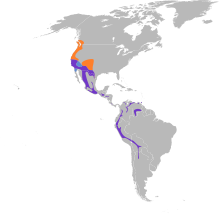This articlemay not providebalanced coverageon a geographical region.(September 2017) |
Theband-tailed pigeon(Patagioenas fasciata)[3]is a pigeon native tothe Americas,being the largest pigeon native toNorth America.They are a native species throughout the Southwestern United States andMexico,extending down toPeru.
| Band-tailed pigeon | |
|---|---|

| |
| InSan Luis Obispo,California, USA | |
| Scientific classification | |
| Domain: | Eukaryota |
| Kingdom: | Animalia |
| Phylum: | Chordata |
| Class: | Aves |
| Order: | Columbiformes |
| Family: | Columbidae |
| Genus: | Patagioenas |
| Species: | P. fasciata
|
| Binomial name | |
| Patagioenas fasciata (Say,1822)
| |

| |
| Synonyms | |
|
Columba fasciata(Say, 1823) | |
Taxonomy
editIts closest living relatives are theChilean pigeonand thering-tailed pigeon,which form acladeofPatagioenaswith a terminal tail band and iridescent plumage on their necks.[4]There are at least 8 sub-species, and some authorities split this species into the northern band-tailed pigeon (Patagioenas fasciata)[5]and the southern band-tailed pigeon (Patagioenas albilinea).[6][7]
Use as genetic proxy
editThe band-tailed pigeon is the closest living relative of theextinctpassenger pigeonand has been investigated for being used inefforts to bring backthat species.[8][9]
Distribution and habitat
editIt ranges fromBritish Columbia,Washington,Oregon,California,and southernArizonasouth in higher elevations throughMexicoandCentral Americato northernArgentina.In autumn itmigratesout of its permanent resident range into northern California,New Mexico,and parts ofUtahandColorado.It is found from almost sea level to 3,600 m (12,000 ft), generally inoak,pine-oak, andconiferousforests. It feeds on seeds, notably acorns, as well as berries and small fruits.
Description
editIt is the largest pigeon inNorth America,measuring 33 to 40 cm (13 to 16 in) long and weighing 225–515 g (7.9–18.2 oz).[10][11]The coastal subspeciesP. f. monilis(averaging 392 g (13.8 oz)) is larger than the inland subspecies (averaging 340 g (12 oz)).[10]The band-tailed pigeon has a wingspan of 66 cm (26 in).[12]
The plumage is gray, somewhat darker above. The head and underparts have a faint pink cast, especially in the adult male; the belly is nearly white. The distal half of the tail is also pale (except in the subspecies ofBaja California), whence the English name. The bill and feet are yellow, with good identification marks at sufficiently close range. Adults have greeniridescenceon the back of the neck, adjacent to a thin white collar on thenape.Juvenile birds have white feather edges above, giving a scaly appearance.
Behavior and ecology
editThis species is relatively quiet for a pigeon. Its voice is low-pitched andowl-like, often in two-syllable calls that rise and then fall (huu-ooh) with even spacing between calls.[13]It also makes a variety of harsh squawking sounds for a variety of reasons.
It builds a rudimentary platform nest out of twigs, in which it lays one or two eggs. Outside the breeding season, it forms flocks, sometimes over 50 birds, and often becomes nomadic, following the acorn crop or moving to lower altitudes or other areas outside its breeding range. They commonly congregate at and drink from mineral springs, although it is not fully understood why. In addition to acorns and other seeds, the band-tailed pigeon will seasonally consume fruits such asPacific madronaandToyonberries.[14]This species often visitsbird feeders.With the introduction ofEnglish hollyandEnglish ivy,two popular plants in landscaping in western North America, the bird is found in persistent numbers in suburban areas now as well.
The parasiticlouseColumbicola extinctus,believed to have become extinct with the extinction of thepassenger pigeon,was recently rediscovered on the band-tailed pigeon.
References
edit- ^BirdLife International (2016)."Patagioenas fasciata".IUCN Red List of Threatened Species.2016:e.T22725264A94888623.doi:10.2305/IUCN.UK.2016-3.RLTS.T22725264A94888623.en.Retrieved11 November2021.
- ^"Patagioenas fasciata.NatureServe Explorer 2.0 ".explorer.natureserve.org.Retrieved10 August2023.
- ^Sibley, David Allen(2000).The Sibley Guide to Birds.New York: Knopf. p.260.ISBN0-679-45122-6.
- ^Johnson, Kevin P.; de Kort, Selvino; Dinwoodey, Karen; Mateman, A.C.; ten Cate, Carel; Lessells, C.M.; Clayton, Dale H. (2001)."A molecular phylogeny of the dove generaStreptopeliaandColumba"(PDF).Auk.118(4): 874–887.doi:10.2307/4089839.hdl:20.500.11755/a92515bb-c1c6-4c0e-ae9a-849936c41ca2.JSTOR4089839.
- ^"Species factsheet: Patagioenas fasciata".BirdLife International. 2014.Retrieved1 November2014.
- ^"Species factsheet: Patagioenas albilinea".BirdLife International. 2014.Retrieved1 November2014.
- ^National Geographic."Band-Tailed Pigeon".National Geographic - Animals - Birds.National Geographic Society. Archived fromthe originalon April 15, 2017.Retrieved18 September2017.
- ^Rich, Nathaniel (27 February 2014)."The Mammoth Cometh".The New York Times.Retrieved28 February2014.
- ^"The Great Passenger Pigeon Comeback".Retrieved2023-08-10.
- ^abDunning Jr., John B., ed. (1992).CRC Handbook of Avian Body Masses.CRC Press.ISBN978-0-8493-4258-5.
- ^"Band-tailed Pigeon".All About Birds.Cornell Lab of Ornithology.
- ^fasciata, Patagioenas; Length: 14.5 "; Wingspan: 26" (2018-08-08)."Band-tailed Pigeon".Bird Watcher's Digest.Retrieved2020-09-27.
{{cite web}}:CS1 maint: numeric names: authors list (link) - ^Mahler, Bettina; Tubaro, Pablo L. (2001)."Relationship between song characters and morphology in New World pigeons".Biological Journal of the Linnean Society.74(4): 533–539.Bibcode:2001BJLS...74..533M.doi:10.1006/bijl.2001.0596.
- ^Hogan, C. Michael (2008). Stromberg, N. (ed.)."Toyon (Heteromeles arbutifolia)".Global Twitcher. Archived fromthe originalon 2009-07-19.
- Howell, Steven N.G.; Webb, Sophie (1995).A Guide to the Birds of Mexico and Northern Central America.Oxford & New York: Oxford University Press.ISBN0-19-854012-4.
- Jiménez, Mariano II; Jiménez, Mariano G. (2002–2003)."Paloma Encinera".Zoológico Electrónico(in Spanish).Archivedfrom the original on 15 December 2006.Retrieved27 November2006.
- Aguilar, Héctor F. (2000)."La paloma torcaza o gargantillaColumba (fasciata)) fasciataSay 1823 (Aves:Columbidae) algunas notas sobre su historia natural en venezuela "[The Band-Tailed PigeonColumba (fasciata)) fasciataSay 1823 (Aves:Columbidae) Some Notes About His Natural History in Venezuela](PDF).Revista de Ecología Latinoamericana(in Spanish).7(3): 29–44. Archived fromthe original(PDF)on 2011-08-13.Retrieved2010-05-23.
External links
edit- BirdLife species factsheet forPatagioenas fasciata
- "Patagioenas fasciata".Avibase.
- "Band-tailed pigeon media".Internet Bird Collection.
- Band-tailed pigeon photo galleryat VIREO (Drexel University)
- Audio recordings of Band-tailed pigeononXeno-canto.

